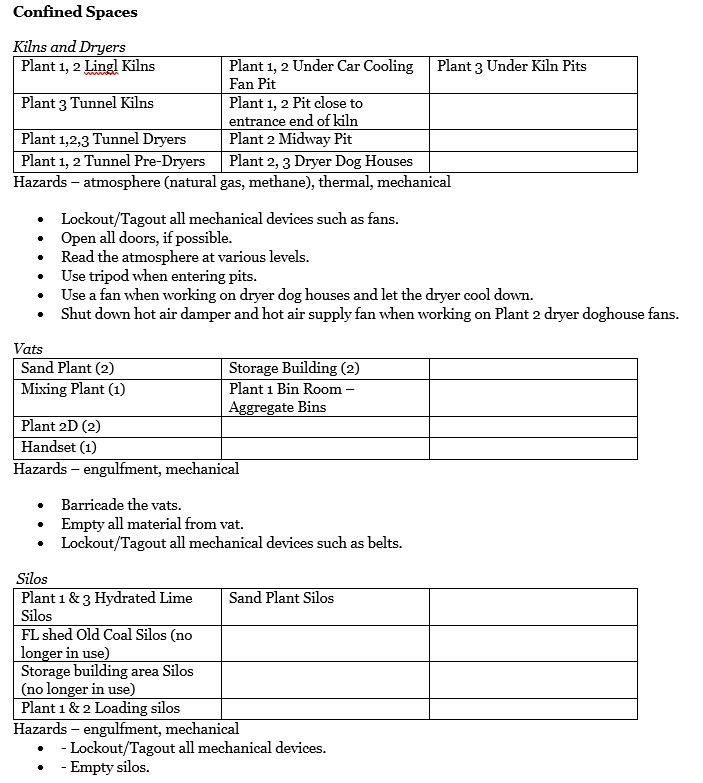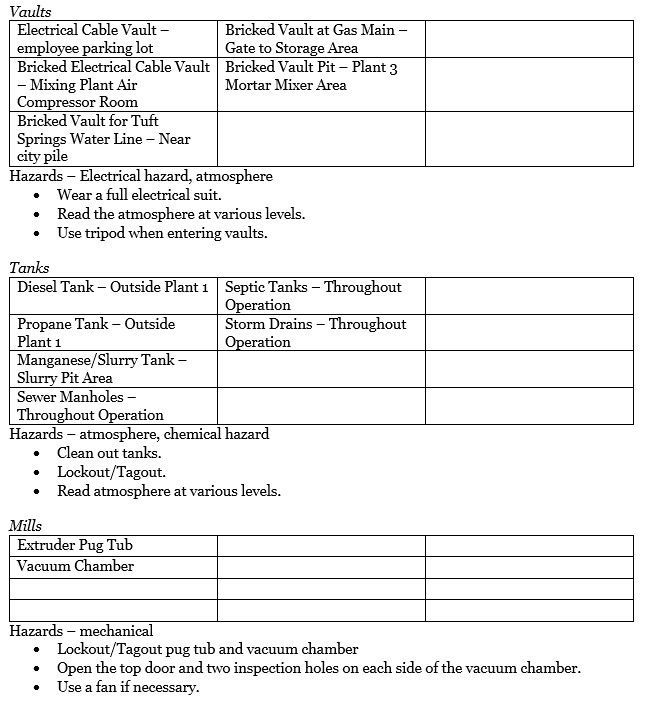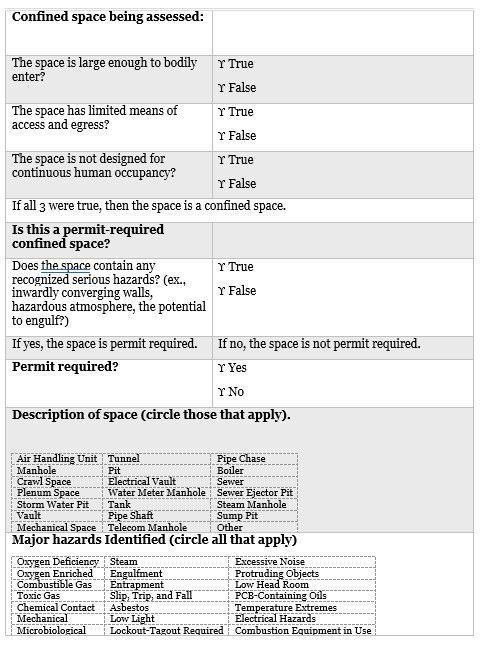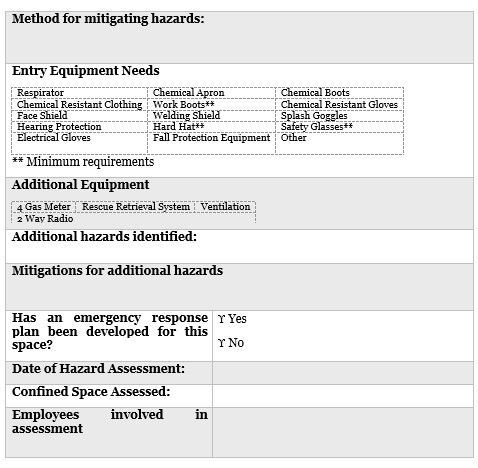Confined Space Program
Purpose and Objective
The company is dedicated to the protection of employees from on-the-job injuries. The purpose of this program is to implement a policy for safe entry into confined spaces. Work in a confined space is highly hazardous. This program outlines the responsibilities of all involved parties. It is intended to provide safety requirements in accordance with OSHA’s Confined Space Standard 1910.146. When properly implemented and maintained, this policy is an important part of an effective confined space program.
Definitions
Acceptable Entry Conditions: The conditions that must exist in a permit space to allow entry and to ensure that employees involved with a permit-required confined space entry can safely enter into and work within the space.
Attendant: An individual stationed outside one or more permit-required confined spaces who monitors the entrants and performs attendant duties.
Authorized Entrant: An employee who is authorized by the employer to enter a permit space.
Blanking or Blinding: The absolute closure of a pipe, line, or duct by the fastening of a solid plate (such as a spectacle blind or skillet blind) that completely covers the bore and that is capable of withstanding the maximum pressure of the pipe, line, or duct with no leakage beyond the plate.
Confined Space: A space with the following characterizations:
- Large enough and configured so that an employee can bodily enter and perform assigned work
- Has limited or restricted means for entry or exit
- Not designed for continuous human occupancy
Double Block and Bleed: The closure of a line, duct, or pipe by closing and locking or tagging two in-line valves and by opening and locking or tagging a drain or vent valve in the line between the two closed valves.
Emergency: Any occurrence (including any failure hazard control or monitoring equipment) or internal or external event affecting the permit space that could endanger entrants.
Engulfment: The surrounding and effective capture of a person by a liquid or finely divided (flowable) solid substance that can be aspirated to cause death by filling or plugging the respiratory system or that can exert enough force on the body to cause death by strangulation, constriction, or crushing.
Entrant: The employee who physically enters the space to perform work.
Entry: The action by which a person passes through an opening into a permit-required confined space. Entry includes ensuing work activities in that space and is considered to have occurred as soon as any body part of the entrant breaks the plane of opening into the space.
Entry Permit: The written or printed document that is provided by the employer to allow and control entry into a permit space.
Entry Supervisor: The employee (such as foreman or crew chief) who is responsible for determining if acceptable entry conditions are present at a permit space where entry is planned, authorizing entry and overseeing operations, and for terminating entry if necessary.
Hazardous Atmosphere: Any atmosphere that has the potential to expose employees to the risk of death, incapacitation, asphyxiation, or the impairment of ability to self-rescue.
Hot Work Permit: The employer’s written authorization to perform operations capable of providing a source of ignition.
Immediately Dangerous to Life or Health (IDLH): Any condition that poses an immediate or delayed threat to life, or that would cause irreversible adverse health effects, or that would interfere with an individual’s ability to escape unaided from a permit space.
Isolation: The process by which a permit space is removed from service and completely protected against the release of energy and material into the space by such means as: blanking or blinding; misaligning or removing sections of lines, pipes, or ducts; a double block and bleed system, or lockout tagout of all sources of energy; or blocking or disconnecting all mechanical linkages.
Limited Means of Entry or Exit: A condition that has a potential to impede an employee’s movement into or out of a confined space.
Non-Permit Required Confined Space: A confined space that does not contain or, with respect to atmospheric hazards, have the potential to contain any hazard capable of causing death or serious physical harm.
Permit-Required Confined Space: A space that meets the definition of a confined space and includes one or more of the following characteristics:
- Contains or has the potential to contain a hazardous atmosphere
- Contains a material with the potential to engulf an entrant
- Has an internal configuration that may potentially cause an entrant to be trapped or asphyxiated by inwardly converging walls or sloped floors
- Contains any other recognized serious safety hazards
Permit System: The employer’s written procedure for preparing and issuing permits for entry and for returning the permit space to service following the termination of entry.
Prohibited Condition: Any condition in a permit space that is not allowed by the permit during the period when entry is authorized.
Rescue: The act of retrieving and providing medical assistance to employees who are in a permit space.
Rescue service: The personnel designated to rescue employees from permit spaces.
Retrieval System: The equipment (including a retrieval line chest or full-body harness, wristlets if appropriate, and a lifting device or anchor) used for non-entry rescue of persons from permit spaces.
Testing: The process by which the hazards that may confront entrants of a permit space are identified and evaluated.
Responsibilities
The company is responsible for evaluating the workplace to determine if any spaces are permit-required confined space. If permit-required confined spaces are present, the company shall inform exposed employees by posting danger signs, or by other equally effective means, noting the location and danger posed by the space. If it is decided that employees will not enter permit-required space, the company is responsible for taking effective measures to prevent employees from entering the space.
Management is responsible for implementing, supporting, and enforcing this program.
The manager of the Confined Space Program is responsible for managing the Program. The manager will be responsible for:
- Maintaining a list of confined spaces at all company locations
- Ensuring that permits are reviewed to identify issues
- Verifying that training of affected personnel is conducted and adequately documented
- Coordinating with outside responders when applicable
- Ensuring that equipment is compliant with standards
- Ensuring that the program is adhered to through periodic audits
- Completing the permit along with the entry supervisor and entrant
Entry supervisors have the key responsibility of ensuring confined space activities are safely conducted. Entry supervisors should ensure that all employees receive training for the company’s requirements and must:
- Know hazards of confined spaces and how to identify signs and symptoms of exposures
- Ensure emergency plans are in place
- Verify that specialized entry mitigations are in place such as permits, tests, procedures, and equipment prior to entry
- Evacuate space and cancel permits when work is complete or if a hazardous condition occurs
- Ensure that rescue services are available and the means for summoning them are operable
- Respond with appropriate measures to ensure that unauthorized entrants are immediately removed from the space
- Check that entry operations are consistent with the conditions of the permit
- Complete the permit along with the entrant and attendant
An entry supervisor may also serve as an entrant or as an attendant. This is permissible as long as that person is trained and equipped as required by this section for each role the individual will fill. The duties of an entry supervisor may also be passed from one individual to another during the course of an entry operation.
Employees are responsible for understanding and participating in reporting accidents and injuries. This is a key piece of the recordkeeping program. Accidents and injuries must be reported in order to ensure employees get care and treatment when necessary. It is also critical for helping management to understand larger trends at the work site and to prevent future incidents.
Confined space entrants are responsible for:
- Knowing the space hazards, including potential means of exposure, as well as signs and symptoms of exposure
- Properly using equipment that is provided
- Using PPE equipment appropriately
- Maintaining communications with attendants as necessary to ensure the attendant can monitor the entrants and alert entrants of dangerous conditions when necessary
- Exiting from the space immediately when:
- The attendant or other authorized person orders a space evacuation
- He or she recognizes signs or symptoms of exposure
- A prohibited condition exists
- An alarm is activated
- Alerting an attendant when a dangerous condition exists
- Completing the permit along with the entry supervisor and attendant
Confined space attendants are responsible for:
- Remaining outside the permitted space during entry operations and only leaving their post when relieved by another authorized attendant
- Performing non-entry rescues
- Knowing the hazards that exist in the space and understanding exposure symptoms
- Maintaining communication with entrants
- Keeping an accurate count of entrants within the space
- Initiating an evacuation when:
- Dangerous conditions exist
- Entrants exhibit signs or symptoms of exposures
- An emergency occurs outside the space
- An attendant cannot effectively perform duties at any time
- Calling for rescue help during an emergency
- Ensuring that unauthorized employees do not enter the confined space
- Informing entrants if any unauthorized person does enter the space
Along with these responsibilities, it is critical that attendants understand they are prohibited from performing any other duties that interfere with the attendant’s primary duties.
The rescue team members are responsible for:
- Completing training drills in a simulation of the confined space rescue at least annually
- Responding immediately to rescue calls
- Participating in rescue training
- Receiving entrant/attendant training
- Having a current certification in CPR and first aid
General Requirements
Confined spaces are prevalent across many industries. It is important to ensure that they are properly identified and that employees are protected by engaging in precautions. A confined space is any space that meets the following criteria:
- Large enough for an employee to enter and perform work
- Not designed for continuous occupancy by employees
- Limited means of entry or exit
Permit-required confined spaces are those that present additional risk to employees. These spaces must only be entered when proper safeguards and permit authorizations are in place. A permit-required confined space is one that meets the following criteria:
- Contains or has the potential to contain a hazardous atmosphere
- Contains materials with the potential to engulf an entrant
- Has an internal configuration that may potentially cause an entrant to be trapped or asphyxiated by inwardly converging walls or sloped floors
- Contains any other recognized serious safety hazards
When evaluating spaces prior to confined space work, it is extremely important to recognize when additional hazards may be present and to take measures that will adequately mitigate those hazards.
Identification of Confined Spaces
The company shall ensure a survey of the worksite and that confined spaces are identified. When work will be conducted in confined spaces, the proper procedures will be prepared prior to entry. The survey should develop an inventory of locations and equipment that meet the definition of a confined space and include those that do or may potentially meet the requirements of a permit- required confined space. Additional information on the spaces must also include a hazard assessment that includes significant hazards that may be anticipated.
The information gained in the survey should be communicated to all employees. Entry procedures must then be developed prior to entries. Signage shall be placed over an entry to a space to notify employees that the area is a confined space. Once the company has identified the hazards of the spaces onsite, a master inventory of confined spaces must be maintained.
Hazard Assessment of Confined Spaces
Prior to any entry into a confined space, a confined space hazard assessment (see Appendix A) must be completed. The hazard assessment must include a visual inspection and should identify:
- The work steps to be performed in the space
- The specific hazards that are known or may be anticipated
- Hazard control measures to be implemented prior to entry
Often confined spaces contain the potential to have hazardous atmospheres. This potential must be part of the confined space hazard assessment. A hazardous atmosphere can be any atmosphere that may expose employees to the risk of death, incapacitation, impairment of the ability to self-rescue, or acute illness from one or more of the following:
- Flammable gas, vapor, or mist in excess of 10 percent of the lower flammable limit (LFL)
- Airborne combustible dust at a concentration that meets or exceeds its LFL such as when dust obscures vision at a distance of 5 feet or less
- Atmosphere oxygen below 19.5 percent or above 23.5 percent
- Atmospheric concentration of any substance that is above the permissible exposure limit
- Any other atmospheric condition that is immediately dangerous to life or health
Once the hazards have been identified, they must be mitigated prior to entry. The hazard assessment must be reviewed by all involved employees before the space can be entered and work can begin.
Entry Permits
Confined space entry permits are an extremely important element of an effective confined space program. Permits help to assure safety by addressing known hazards, assigning duties, and maintaining a log of entrants. The permitting process guides the entry supervisor, entrant, and attendant through an evaluation of the space. The permit assists in the establishment of safe entry conditions. Prior to entry into a confined space, the entry supervisor will complete the permit along with the entrant and attendant.
The following information must be completed prior to permit-required confined space entry:
- Space to be entered (number or description)
- Purpose of entry
- Date of permit use
- Names of authorized entrants inside the space
- Names of attendants and duration of duties
- Name of entry supervisor who authorized entry
- Hazards of the permit-required confined space
- Mitigating measures to isolate the space (lockout/tagout, purging, washing, etc.)
- Acceptable entry conditions
- Results of initial confined space atmospheric monitoring
- Rescue and emergency service contact information
- Communication methods used between the entrants and attendants
- Equipment provided (PPE, air monitors, radios, etc.)
- Any other necessary information for safety
- Authorization signatures
- Any other permits that may be used such as hot work permits
When completing a permit, all information must be entered and all mitigations must be in place. It is imperative that documentation is correct and maintained throughout the confined space entry.
Pre-Entry Meeting
When entry into a permit-required confined space is necessary, an entry supervisor must complete the permit and ensure that the entrant and attendant are aware of the identified hazards and mitigations. The purpose of this group effort is to ensure that all involved employees are available to recognize and mitigate hazards prior to entry. In cases where an entry supervisor is also acting as the entrant or attendant, that individual should sign on the entry supervisor line as well as either entrant or attendant. Entry is only to be allowed when the permit has been reviewed and signed by applicable parties.
Entry Procedures
The following conditions must be met before entry can be initiated:
- Affected personnel shall be trained to ensure that the responsibilities of their roles are understood
- All hazards identified must be mitigated to ensure the environment is as safe as possible
- The internal atmosphere must be tested using a calibrated, direct-reading instrument
- Personnel must be provided with all necessary PPE as determined by the entry supervisor
- Atmospheric monitoring must be conducted and performed
When entrance covers are removed, the entrance into the space left behind may potentially create a fall hazard. The space opening shall be promptly guarded by a railing or other temporary barrier or cover that will prevent employees from falling into the opening. The barrier must also cover or protect entrants from objects falling through the opening. If there is vehicle traffic in the area, adequate barriers to stop vehicles must be erected.
Atmospheric Testing
Atmospheric testing is required prior to entry into the permit-required confined space. This ensures that a hazardous atmosphere is not present and that conditions within the space are safe for entry. Before entry, the entry supervisor must conduct testing for hazardous atmospheres with a calibrated, direct-reading instrument that measures oxygen, flammable gases, vapors, and potential toxic air contaminants. Testing should look at all levels of the space to be entered since some gases may be heavier or lighter than air. This equipment must be approved by a nationally recognized laboratory such Underwriters Laboratories or Factory Mutual Systems.
When conducting atmospheric monitoring, there are two types of monitoring that should be evaluated for use in the space and recommended by the entry supervisor. Evaluation testing is the initial testing prior to entry that identifies if the space meets the conditions necessary for work to begin. Verification testing is testing that is conducted throughout the duration of the space entry to ensure that the space remains safe. This testing should be conducted with approved equipment and the entry supervisor must determine the frequency of testing.
If conditions change and a hazardous atmosphere is detected within the space during entry, the permit-required confined space shall be evacuated immediately. Controls such as signs or barricades must be placed over the entrance to ensure employees do not reenter. If conditions exist that make removing an entrance cover unsafe, those conditions must be eliminated before the cover is removed.
Isolation and Lockout/Tagout Safeguards
All energy sources that could potentially impact a confined space must be isolated prior to entry. Equipment or systems associated with the space must be locked out and tagged out as required by OSHA 29 CFR 1910.147. A verification of positive isolation must be conducted prior to entry into the space. This isolation must ensure that all energy sources are secured, relieved, disconnected, or drained prior to entry.
Access/Egress Safeguards
A method for safe entry and exit of the space must be provided. Each entry must have an effective means for employees to enter as well as provide adequate access for tools and equipment. Retrieval methods must also be considered whenever a person enters a confined space. The entry supervisor may require retrieval equipment if the risk of entry does not provide for adequate rescue methods. A mechanical device will then be made available to retrieve personnel from spaces greater than five (5) feet in depth.
Signage
All confined spaces that could inadvertently be entered must have signs posted identifying them as confined spaces (see example in Appendix B). Signs must legible and contain a warning that a permit is required for entry. All access points must be clearly marked.
Communication and Coordination in Permit-Required Confined Spaces
When the company arranges to have contractors or similar vendors perform work in permit-required confined spaces, the company shall:
- Inform the contractor that the site contains permit spaces and that the permit space entry is only allowed through the permit system
- Inform the contractor of any precautions or procedures that the host employer has implemented for the protection of employees in or near permit spaces
- Coordinate entry operations with the contractor
- Debrief the contractor at the conclusion of entry operations regarding the permit space program and any hazards encountered
Conducting Work in the Permit-Required Confined Space
Once a permit has been approved and an entry into the space has been conducted, the work within the space may begin. During the work process, the entrant is responsible for conducting work and maintaining communications with the attendant. The attendant must remain vigilant and periodically establish contact with the entrant to ensure that lines of communication are open. Both the entrant and attendant must know the signs and symptoms of exposure and observe if any behaviors are early indications of problems. If at any time during the duration of work the attendant calls for an evacuation, the entrant must exit the space immediately until it can be confirmed safe.
Alternate Entry Classification
All confined spaces are to be considered permit-required unless the employer has reclassified them. Prior to reclassification, the hazards must be evaluated and the atmosphere must be tested.
Alternate procedures for entry may be used instead of permit-required procedures when each of the following conditions are met:
- The company can demonstrate that the only hazard posed by the permit space is an actual or potential hazardous atmosphere
- The company can demonstrate that continuous forced-air ventilation alone is sufficient to maintain that the permit space is safe for entry
- The company develops monitoring and inspection data that supports the previous conclusions
- If initial entry into the space is necessary to obtain data in order to support that hazards are eliminated, the entry is performed according to the procedures in this document
- The determinations and supporting data required must be documented by the employer and made available to each employee who enters the space
Employees who enter into confined spaces using alternative entry methods must implement and comply with the alternative entry procedures in this program.
Alternate Entry Procedures
The following requirements must be followed prior to entry into permit spaces that meet the classification for alternate entry.
- Conditions that make it unsafe to remove the entrance cover must be eliminated prior to cover removal
- The opening to the space must be immediately guarded by a railing, barrier, or temporary cover that will prevent an accident fall through the opening and will protect the employee working in the space from foreign objects entering the space
- Atmospheric testing must be conducted and continuously monitored for the duration of entry operations
- No hazardous atmosphere will be permitted while an employee is inside the space
- Continuous forced-air ventilation will be used as follows:
- Employees may not enter the space until the forced-air ventilation has eliminated any hazardous atmosphere
- Forced-air ventilation shall be directed to ventilate the immediate areas where an employee is or will be present and shall continue until all employees have left the space
- The air supply for forced-air must be from a clean source and must not increase hazards in the space
- The atmosphere in the space shall be periodically tested to ensure the atmosphere is not hazardous
- If a hazard is detected, the employee must leave the space immediately and hazard evaluation must occur
- Measures must be implemented to protect employees prior to re-entry of the space
- A safe method for entering and exiting the space must be provided
- Where changes in the configuration of the space may increase hazards, the space must be re-evaluated by the employer
Re-classification to a Non-Permit Required Confined Space
Entry into a confined space need not comply with the permit-required or alternative entry procedures provided that:
- It can be demonstrated that the space poses no actual or potential atmospheric hazards and all potential physical hazards are eliminated without requiring entry into the space.
- The permit-required space may be reclassified as a non-permit required space for as long as the atmospheric hazards remain eliminated.
- If it is not necessary to enter the permit space to eliminate hazards, an entry shall be performed by following the permit-required confined space procedures. If testing and inspection during this entry demonstrate that the hazards within the permit space have been eliminated or isolated, the permit-required space may be reclassified as a non-permit-required confined space as long as hazards continue to be eliminated or isolated.
- If hazards arise within a permit space that has been declassified as non-permit required, each employee must exit the space. The space shall then be reevaluated by the employer to determine whether it must be reclassified.
The employer shall document the basis for determining that all hazards in a permit space have been eliminated by a certification that contains the date, location of the space, and the signature of the person making the determination. The certification must be made available to any employee entering the space.
Emergency Response
Emergency Response Plans
The company shall maintain an inventory of rescue action plans for conducting a timely response for individuals who are working in a confined space in the event of an emergency. This plan must be maintained onsite at the location where work is being conducted so that it can be communicated to emergency responders. All personnel involved in the space entry must also understand the components and measures listed in the emergency rescue plan.
Retrieval and Non-Entry Rescue
The hazards of entering a confined space are serious and often would-be rescuers can fall victim to the same hazards that affected entrants. For that reason, retrieval system or non-entry rescue systems may be preferable. Retrieval systems must only be used in spaces in which use of a retrieval line will not cause an additional hazard for the entrant. Retrieval systems must be certified to be used for retrieval and include a properly fitted harness and a retrieval line that attaches to the center of the back. The retrieval line must be securely fastened outside the space so that rescue can begin as soon as possible.
Training Requirements
It is critical that all training is documented. Before initial work assignments that involve confined spaces, the company will conduct training for all involved employees. After training, a skill check will be performed to ensure that employees have acquired the understanding, knowledge, and skills needed to safely perform their work. Additional training is required when:
- Job duties change
- A change occurs in the confined space program or the permit space operation presents any new hazard
- An employee’s job performance shows deficiencies
Permit-required confined space training must include:
- Information on the nature of the hazards involved in confined spaces
- Actions to take when exposed to hazards
- How to arrange for a rescue
- How to use air monitoring equipment
Confined space safety training must be conducted:
- Before new employees begin work in confined spaces
- When there is a change in assigned duties
- When there is a change in the permit-required confined space program or operations
- When there are any issues with the employee’s confined space performance
Entrants must be trained on:
- Hazards of confined spaces
- Signs and symptoms of exposure to hazards
- Evacuation procedures
- Lockout/tagout procedures
- Method to call for rescue services
Attendants must be trained on:
- Hazards of confined spaces
- Signs and symptoms of exposure to hazards
- Non-entry rescue procedures
- Conditions that prompt an evacuation of a permit-required confined space
- Method to call for rescue services
- How to respond to unauthorized entrants in a confined space
Entry supervisors must be trained on:
- Hazards of confined spaces
- Signs and symptoms of exposure to hazards
- Entry permitting process
- Use of air monitoring equipment
- Emergency rescue procedures
- How to respond to unauthorized entrants in a confined space
In addition to this training, rescue team members also require training in CPR and first aid. The company is responsible for ensuring that this training has been provided.
When creating training, it is important that a formal process is observed. The topic of the training should clearly communicate the content of the material to be covered. Only employees who have knowledge of the material and are qualified should conduct training. An explanation of trainer qualifications may vary from subject matter expertise to a specialized degree in a certain field; however, the important element is that the trainer has a thorough understanding of the topic and can respond to questions from the trainees. In addition, the content of the training must be maintained. That will serve to be a reference on the topics covered during the training for future use, so, documentation must be complete.
Recordkeeping
It is critical that all training is documented. This documentation must be comprehensive and will include:
- Topic of training
- Trainer(s)
- Trainer qualifications
- Date of training
- Employee name
A written program is required to be developed and maintained for employees who enter confined spaces. This program must be maintained and reviewed annually.
Confined space permits that have been canceled must be retained for one calendar year after each entry.
Confined Spaces





Appendix B – Confined Space Danger Sign

